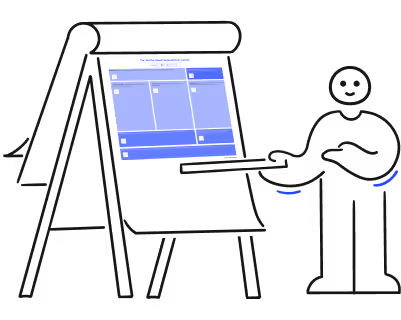How much does the average learning management system cost?

Empower your organization with the skills-based canvas.

A number of factors should be considered when it comes to purchasing a corporate learning management system (LMS). In this article, we break down the costs of LMS platforms, explain the different LMS pricing models, and share tips designed to help you choose the LMS solution that best meets your needs.
What is a learning management system?
A learning management system (LMS) is software that is installed on a web server and used to create, manage, organize, and deliver virtual educational materials and activities. LMS platforms offer the possibility of synchronous, as well as asynchronous, learning. As a result, users can use them online as well as offline.
Discover how to choose the right learning management system here!
What is included in the price of an LMS?
The cost of an LMS usually covers the following features:
- Data tracking
- LMS integration
- Personalized user experience
- Centralized learning materials
- Automatic notifications and alerts
- Flexible reporting and analytics
- Etc.
What is the average cost of a corporate LMS?
The average cost of a corporate LMS is usually around $5,000 for SaaS configurations. However, there are vendors whose rates are close to $25,000, especially when the LMS is hosted on the customer's server.
The price can vary a lot depending on the number of employees who use the LMS. For example, prices start at $2000 for 25 employees and then increase according to the number of users. For 1000 users, companies can expect to pay around $20,000.
LMS expenditure at a glance
One-time set up cost
Setting up an LMS platform comes with a one-time fee. This fee has to be paid all-at-once while purchasing the platform. Some vendors include basic services such as training around the use of the platform, white label or custom options, and elementary integrations in their set up costs. If you want to avoid paying set up costs, installation is 100% free with Workleap LMS!
Recurring costs
Most LMS platforms come with recurring costs. This means that, after the platform has been set up, you will be required to make yearly payments to keep it active. You can choose between different yearly plans. Some are designed to focus on factors such as the total number of learners registered to use the platform, while others only charge for the number of active, registered users on the platform during a given period.
The most commonly used type is the latter, which means that you only pay on the basis of the number of users who have registered to use the platform in a given year, and not on the total number of learners on the LMS. There is also the alternative of charging recurring costs, according to the use given to the platform, as well as for maintenance, patches, or any other activity performed by the LMS provider. If the LMS is self-hosted, recurring costs may have to be paid after a longer period of time, such as when a license is purchased.
Hidden costs
Some platforms come with hidden costs for customers that usually don’t arise, until after they have purchased and started using the LMS for staff training. These usually consist of feature customizations that organizations may decide to add, after they have started using the LMS service or integrations with other enterprise software such as CRMs or ERPs. Thankfully, companies that choose Workleap as their corporate LMS solution don’t have to deal with hidden fees!
Here are the 5 must-have features of a learning management system.
LMS pricing models
Perpetual license fee
Perpetual license fees involve paying to use the LMS for a fixed period of time. Although this is often the least commonly-used LMS pricing model, it is preferred by large corporations that have large pockets and are concerned about the security of their data.
Yearly users
Pay-per-learner is a good alternative for companies that want to have predictable billing rates, since they only have to train specific staff each year. In this sense, for each billing cycle, the company will pay a fixed and constant amount for each user accessing the LMS, which can be a pretty cost-effective model.
Active users
This is one of the most economical LMS pricing options. It is therefore recommended for small or new companies that expect rapid growth. What makes it an attractive proposition financially is that it only takes into consideration the use of the platform. You pay for the users that actively use the platform, and not the total number of registered users. This is Workleap LMS' pricing model!
Open source LMS
An open source LMS can be used for free because its code is freely available for anyone who needs to use it. Although at first you may think that free software will not generate expenses, the truth is that it is often necessary to hire service providers to help configure, manage, customize the LMS, and train employees to use the platform. We recommended this type of software only if your company has an innovation and technology team.
How to choose the best LMS pricing model
Scalability
When buying an LMS, it’s important that you choose one that can continue to be used seamlessly if your company experiences growth and begins to incorporate more employees. You need to make sure that the LMS solution you choose can grow with your company if advanced features need to be added.
Having to make a platform change will entail significant costs for the organization and the use of a lot of resources. After all, time would have to be spent on data migration and training around the operation of the new software.
Mobile solution
Mobile device friendliness is another criterion you should take into account when choosing a learning management system cost model. After all, many employees enjoy using their mobile devices to access platforms when doing their online courses. Buying a cheap platform that isn’t mobile-friendly can end up costing you money.
Analytics
LMS platforms should also be able to generate efficient reports that can be used by organizations to know if they are carrying out best practices when training their employees. Before reaching for your corporate credit card, it’s important to evaluate whether the LMS solution provides reports in their package. You may also need to consider whether it’s important to create a custom reporting dashboard or integrate with your preferred third-party reporting tool.
Ease of use
Ease-of-use is an essential consideration when shopping for an LMS, since not all employees have the same know how when it comes to digital tools. Intuitive virtual learning environments are key for employees to feel motivated during training. The LMS user interface should therefore be easy to navigate and have a pleasant design.
Third-party integrations
When choosing an LMS platform, it’s important to make sure that it can be properly integrated with your existing software. In this regard, there are some aspects to consider around the cost of these services. These include the development costs of the integrations themselves, the possibility that the LMS may require additional costs, and costs that might be incurred should the third-party software service be offered as part of a separate payment plan.
Customization
A corporate LMS platform should incorporate elements of a company’s visual identity, such as logo and branding colors.
Course creation platforms
An LMS with an inbuilt online course creator can save you a significant amount of money, as having to pay separately for this can be costly.
The best LMS for businesses
If you want to choose a digital platform that offers solutions tailored to the requirements of your corporation, Workleap LMS stands out by offering learning service packages based on customer requirements and the nature of your business. Our unique platform stands out due its ability to adapt to the constant changes in the digital ecosystem, and its unique set of features. Using this virtual medium, you will have the ability to track your employees and set personalized learning paths that perfectly match individual learning needs.
%20(1).png)

%20(1).avif)


.avif)
.avif)








